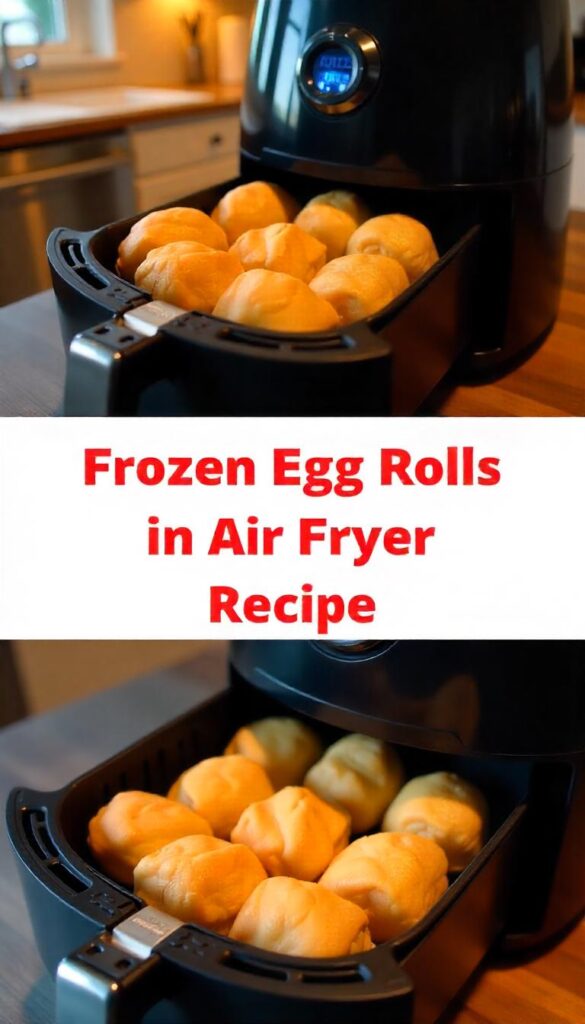Frozen egg rolls are a popular appetizer or snack that offer a perfect combination of crispy exteriors and savory fillings. Traditionally deep-fried or baked, egg rolls can now be effortlessly prepared in an air fryer for a healthier and faster alternative. Whether you’re serving guests, looking for a midday snack, or preparing a quick side for dinner, using the air fryer delivers deliciously golden egg rolls without the mess of oil or the hassle of preheating the oven.
This frozen egg rolls in air fryer recipe takes the guesswork out of cooking frozen food, ensuring consistent results every time. No thawing needed—just place them in the air fryer basket and enjoy perfectly crispy egg rolls in under 15 minutes. From vegetable to chicken to pork varieties, this method works for almost any store-bought frozen egg roll brand.
Nutrition Information (Per 1 serving — approx. 1 egg roll)
-
Calories: 160–200 kcal
-
Carbohydrates: 22–26g
-
Protein: 4–7g
-
Fat: 6–9g
-
Saturated Fat: 1–2g
-
Cholesterol: 5–15mg
-
Sodium: 400–600mg
-
Fiber: 1–2g
-
Sugar: 1–3g
Note: Nutritional values can vary depending on the brand and filling (vegetable, pork, chicken, etc.) of the frozen egg rolls.
Prep Time, Cook Time & Other Details
-
Prep Time: 1 minute
-
Active Time: 12 minutes
-
Resting Time: 2 minutes
-
Total Time: 15 minutes
-
Cuisine: Asian-American Fusion
-
Course: Appetizer / Snack
-
Servings: 4 (1 egg roll per serving)
-
Calories per Serving: ~180 kcal
Equipment Needed
-
Air Fryer (basket or tray-style)
-
Kitchen tongs
-
Cooking spray (optional)
-
Thermometer (optional, for checking internal temp)
Ingredients
-
4 frozen egg rolls (any variety: chicken, pork, shrimp, or vegetable)
-
Optional: Light cooking spray (for extra crispiness)
-
Optional: Dipping sauces (sweet chili, soy sauce, plum sauce, etc.)
Instructions
Step 1: Preheat the Air Fryer (Optional)
While most modern air fryers don’t require preheating, doing so can help cook the egg rolls evenly. If your model suggests preheating, set it to 370°F (188°C) for 3 minutes.
Step 2: Arrange the Frozen Egg Rolls
Place the frozen egg rolls in a single layer inside the air fryer basket or tray. Do not overcrowd—there should be space between each roll to allow for air circulation. No need to thaw them beforehand.
Optional Tip: Lightly spray the egg rolls with oil to enhance crispiness. This is especially helpful if you like a deep-fried texture without the oiliness.
Step 3: Air Fry
Set the air fryer to 370°F (188°C) and cook for 10–12 minutes, flipping them halfway through at the 6-minute mark. Flipping helps to brown both sides evenly.
Step 4: Check Doneness
The egg rolls should be golden brown and crispy on the outside. If you’re unsure, insert a thermometer to check that the internal temperature reaches at least 165°F (74°C) for safety—especially important for meat-filled rolls.
Step 5: Let Rest & Serve
Allow the egg rolls to rest for 2 minutes after cooking. This allows the filling to cool slightly and the wrapper to firm up. Serve hot with your choice of dipping sauce.
Optional Dipping Sauce Ideas
-
Sweet Chili Sauce: Sweet with a touch of heat—perfect for all egg roll varieties.
-
Soy Sauce + Sesame Oil: Simple and savory combo for a salty dip.
-
Plum Sauce: Great for pork egg rolls.
-
Sriracha Mayo: For spice lovers. Mix 2 tbsp mayo with 1 tsp sriracha.
-
Garlic Hoisin Dip: Mix hoisin sauce with a little garlic and soy sauce.
Tips for Success
-
Don’t overcrowd the basket: Overlapping egg rolls can cause uneven cooking. Always cook in batches if necessary.
-
Avoid soggy rolls: Skip thawing. Air frying frozen ensures a crispy texture.
-
Reheat leftovers: Pop back in the air fryer at 350°F (175°C) for 3–4 minutes to restore crispiness.
-
Customize seasoning: Lightly dust the cooked rolls with chili powder, garlic powder, or sesame seeds for added flavor.
Why Use an Air Fryer for Frozen Egg Rolls?
Air fryers are designed to mimic deep frying but use little to no oil. They work by circulating hot air rapidly, producing crispy results similar to frying but with 70–90% less fat. With frozen egg rolls, the air fryer delivers a crunchy texture without drying out the filling—something that’s often hard to achieve in an oven.
Other benefits:
-
No need to preheat an oven or use a deep fryer.
-
No excess grease or oil splatter.
-
Healthier and cleaner option.
-
Perfectly cooked in minutes.
Storage and Reheating
To store: Let leftovers cool completely and store them in an airtight container in the refrigerator for up to 3 days.
To reheat:
-
Air Fryer: 350°F for 3–4 minutes
-
Oven: 375°F for 10 minutes
-
Microwave: Not recommended (can turn egg rolls soggy)
Frequently Asked Questions (FAQs)
1. Can I use homemade egg rolls instead of frozen?
Yes, but adjust the cook time slightly based on their size and filling. Homemade egg rolls typically take 12–15 minutes in the air fryer.
2. Do I need to oil the egg rolls?
Not necessary, but a light spritz of oil helps enhance crispiness and browning.
3. What temperature is best for air frying egg rolls?
370°F (188°C) is ideal for most brands, balancing even cooking and crispiness.
4. What brands work best in the air fryer?
Popular options like Chung’s, Tai Pei, Trader Joe’s, PF Chang’s, and Feel Good Foods all cook well in air fryers. Just adjust time based on thickness.
Final Thoughts
Cooking egg rolls has never been easier or healthier than with this frozen egg rolls in air fryer recipe. Whether you’re craving a quick snack or serving appetizers at your next gathering, this air fryer method ensures crisp, golden results in just minutes—no oil, no hassle, and no compromise on flavor. Keep a box of frozen egg rolls in your freezer and your air fryer at the ready—you’ll always be just a few minutes away from a delicious treat.

I am Ashley Doyle, Senior Specialist in Food & Policy at The Humane Society of the United States and editor at airfryermama.com. I am passionate about transforming our global food system by promoting delicious, climate-friendly, plant-based foods. After transitioning from law to food and public policy, I now work with major food service companies to develop plant-based initiatives and animal welfare policies. My goal is to drive institutional change to combat climate change and improve our food system.


